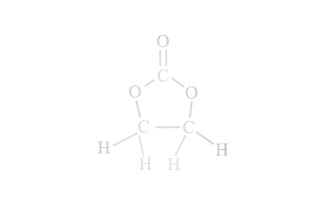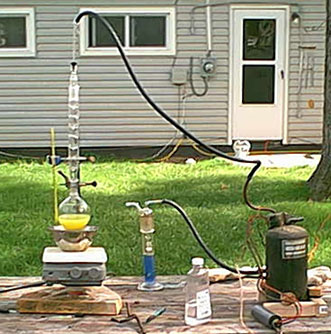
Ethylene Carbonate


Step 1:
Urea and ethylene glycol are mixed along with a catalytic amount of zinc oxide powder. As an example, in one run of this experiment 90 grams of urea and 120 grams of ethylene glycol were used along with four grams of zinc oxide(1). The reaction is allowed to proceed under vacuum, [In the above picture supplied by an air conditioner compressor] near the boiling point of the mixture ~145 °C, for at least 2 hours though I often go longer to compensate for my crummy vacuum. Afterwards the impure ethylene glycol mixture looks like is shown above in the round bottom flask, the following approximated reaction carried out:
HOCH2CH2OH + H2NCONH2 --(ZnO)--> 2NH3 + (-OCOCH2CH2-)
The main purpose of the vacuum being to drive the reaction foreword by constantly removing the ammonia gas as it is formed. In the above picture the gas wash bottle, which is located after the compressor, was originally filled with dilute sulfuric acid to neutralize the ammonia. However as it became saturated and the ammonia and water reacted with the tubing in the compressor, tetraamine copper formed and made its way into the gas wash bottle, coloring it dark blue.

Step 2:
To remove the zinc oxide, the mixture is best filtered hot or at least warm, vacuum filtration being necessary, filtering through cotton balls easier then through a coffee filter. After filtration the filtrate is allowed to cool to near room temperature then capped and cooled in a freezer for several days undisturbed. The liquid will eventually freeze, the solid highest in ethylene carbonate freezing out first. After 80% of the liquid is frozen the top liquid is discarded as it likely contains mostly unreacted ethylene glycol and impurities in the antifreeze and such.
Step 3:
The solid that remains may well remain solid to room temperature and above and likely contains excess urea even though the urea is said to react completely in the patent these experiments are modeled after. Never the less the solid is melted and put into a flask and into a setup for distillation. An equal volume of xylene(2) is then added, toluene also would work. The mixture is put under magnetic stirring and distilled, the first fraction coming over at ~116 °C and the bulk of it coming over at about 122 °C. Both of these temperatures being lower then the xylenes or the ethylene glycol. The point being that there is a azeotrope between the two that exists in literature and shows itself quite readily under these conditions composed of approximately 81% xylene and 19% ethylene glycol. In this way the purpose is to have the azeotrope remove the ethylene glycol to avoid the distillation of both ethylene glycol and ethylene carbonate simultaneously, their boiling points being too similar to fraction. The problem here being I got a sublimate in the apparatus (urea, ethylene carbonate?) and ended up with a mostly liquid product in my reaction flask, eventually I will get to distilling that all together. Hopefully if there is no azeotrope between xylene and ethylene carbonate I may get somewhere.
(1) The zinc oxide was produced by first saturating some hydrochloric acid with zinc and then neutralizing and adding sodium hydroxide until a large amount of precipitate was observed. The thick gelatinous precipitate was filtered and washed and dried thoroughly first at ambient temperature then at higher temperatures to decompose the hydroxide and leave behind zinc oxide which was ground with a mortar and pedestal.
(2) The xylene used here was purchased from a home supply warehouse and was fractioned from it, this particular fraction being collected within the proper boiling point range for mixed xylenes, the remaining liquid in the flask was off yellow.